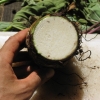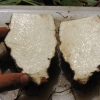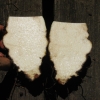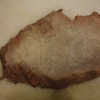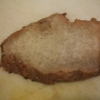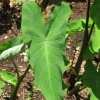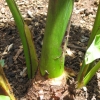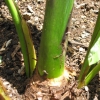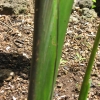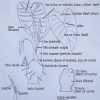Use As Food
Used primarily as a table taro. Some consider the flavor superior to both Lauloa Palakea Ke‘oke‘o and Lauloa Palakea ‘Ula. Highly favored as a medicinal taro by the early Hawaiians. Taro of Lauloa group were used by the early Hawaiians for medicinal purposes, chiefly in pulmonary disorders.
Distribution
Grown extensively in Kona, Hawai‘i, almost exclusively as upland taro, where the air temperature and water is cooler.
General Characteristics
Tall, erect, stocky, maturing within 8 to 12 months, producing from 5 to 10 oha, the conspicuous black edge is a distingnishing feature.
Ha (Petiole)
100 to 140 cm. long, dark green heavily suffused with dark reddish-purple especially on upper half, dark purplish at apex, white at kōhina (base), conspicuously blackish at edge.
Lau or Lu'au(Leaf Blade)
45 to 65 cm. long, 30 to 40 cm. wide, 35 to 50 cm. from tip to base of sinus (māwae), arrow head shaped, slightly concave (curve inward), dark green; margins with a few large undulations; piko purplish; veins dark purplish on lower surface of round leaf section (lobes) round leaf section (lobes) obtuse with narrow lihi māhae (sinus).
'I'o kalo (Corm)
Flesh chalky white with yellowish fibers; skin white or yellowish.
Pua (Flower)
Hā (peduncle) yellowish-green with faint brownish tinge, often reddish-purple at apex; flower cover (spathe) 32 to 37 cm. long, the lower tubular portion 5 to 6 cm. long, reddish-purple, the upper portion dark yellow with reddish-purple margins, bent and drooping, usually tightly folded but sometimes slightly open near constriction (skinny part of flower); spadix (spike of flower) about 11 cm. long, the sterile appendage (tip of flower's spike) conspicuous, about 13 mm. long.
Remarks
This variety is one of the hardiest of the taros, withstanding adverse (difficult) weather conditions under which other varieties will not survive. Under favorable conditions it yields well and is comparatively early maturing. It is popular for medicinal purposes.





